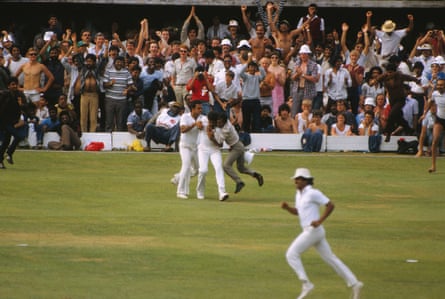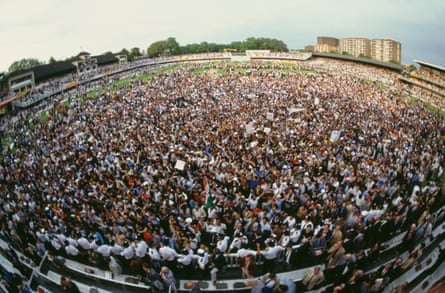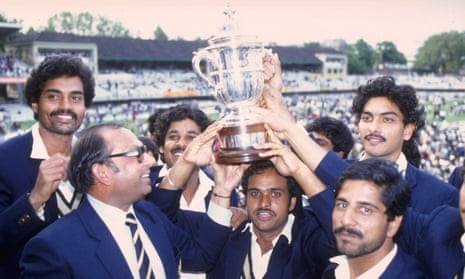I can recall that day only in flashes. A Sony Trinitron colour TV encased in a hefty wooden box, my dad’s walrus-moustached friend Mukulesh in a bush shirt, his demure saree-clad wife Shobha, our new home in Bombay still reeking of fresh paint, my mosaic-tiled bedroom, the sound of cricket commentary, the smell of fried cumin wafting in from the kitchen, the clinking of glasses, my parents squealing in delight, firecrackers going off that Sunday evening.
“Remembrance of things past is not necessarily the remembrance of things as they were,” said Marcel Proust. Did that day happen the way I remember it or have I created those memories through the course of several retellings? I’m not sure, but my parents can confirm most details. I was four. It was 25 June 1983 – the day India won the World Cup at Lord’s.
It was a day that changed Indian cricket, a day that changed India. It changed Sachin Tendulkar. “I celebrated til late in the night after getting permission from my parents,” he said. “I was inspired to take up playing the game with the season [hard] ball after the 1983 World Cup victory. Had it not happened things could have been different for me.”
For years after, I would hear about that day. A rampaging Viv Richards, Kapil Dev running backwards to catch him, Jimmy Amarnath’s man-of-the-match performance and thousands of Indians invading the pitch – these vignettes were narrated over and over, embellished with every telling. It was many years until I saw a replay of Kapil’s catch, but I could have sworn I had watched it on a loop. No father in the 1980s ever tired of talking to his children about that magical, morale-boosting win. India’s leading newsmagazine at the time – India Today – titled its cover story: “Miracle at Lord’s: Indian cricket’s finest hour.”
And what a miracle it was. The team capable only of – in captain Kapil’s own words – “a surprise or two”, beat the 50-1 odds to lord it over the home of cricket. For a poverty-stricken nation, recovering from the throes of the Emergency and Nehruvian socialism, cricket was less a game, more a metaphor for life. And nowhere was that metaphor more evident than in India’s conflicted relationship with Lord’s, with its underpinnings of race, colour, class and colonialism. Lord’s was regarded as the ultimate bastion of imperialism – a private gentleman’s club, with an emphasis on order and rules, and a white, privileged, male outlook on life. To win the World Cup at Lord’s was to triumph over all it stood for.

These tensions were apparent right from the start: when India were meant to play their first Test, against England in India. A series originally scheduled for 1930–31 coincided with the outbreak of the Civil Disobedience Movement in India, including the Salt Satyagraha. When Mahatma Gandhi began the march from Sabarmati Ashram in Ahmedabad to Dandi to protest against the draconian British laws on salt manufacturing – so “shaking the foundations of the British empire”, as he put it – there was outrage in India that an English cricket team would be visiting the country. The tour had to be called off.
The two teams eventually met, two years later, with the All India team – as it was known then – travelling to England to play one Test, at Lord’s, and several county games. “While Gandhi was languishing in jail, the Indian cricket team to tour England was being chosen,” writes Ramachandra Guha in A Corner of a Foreign Field. “Interestingly two Indians appeared for their counties against the tourists. Duleepsinhji played for Sussex and the Nawab of Pataudi for Worcestershire. Both had disdained to appear in the colours of All India, hoping rather to be chosen for that winter’s tour of Australia by England. Both were selected, although Duleep dropped out through illness. While India was still ruled by the British such anomalies were possible. It is notable, though, that neither was asked to play for England against India in the solitary Test of 1932.”
As the anti-British sentiment raged on in India, the Indian and English teams presented themselves before King George V at Lord’s. Jahangir Khan – who featured in the 1932 Lord’s Test – said the Indians felt “slightly nervous because they had never played a Test match and there were so many people shouting.” England won by 158 runs, but not before the Indians had created a stir with three quick wickets on a lively first-day pitch. England wicketkeeper Les Ames said India’s bowling was up to standard, but not their batting. Had the “two very fine Indians” – Duleepsinhji and the Nawab of Pataudi – been in the side “there could have been, well, a different story to the match.”
Intriguingly, three decades before Duleep and the Nawab were not picked despite being eligible, MCC decided against including Duleep’s uncle Ranjitsinhji in a Test at Lord’s against Australia during the 1895–96 season. Lord Harris, the MCC president, believed only “native-born” cricketers should be chosen. “This, depending on how you look at it, was either rank hypocrisy or outright racism,” writes Guha. “For Harris had been born in the West Indies himself.”
But Ranji was then picked for the Test at Old Trafford, because the Lancashire committee wanted him to play (in those days, the host county – or MCC at Lord’s – chose the England team). At the heart of India’s conflicted relationship with Lord’s, then, is the colonial baggage Indians carried that often resulted in deference to the ground’s traditions and everything it stood for: the desperate desire to see their name on the honours board, the awe with which they regarded the Long Room and – in some cases – their urge to prove a point with empire-strikes-back vengeance.
For Jack Bannister’s Innings of My Life, Mohammad Azharuddin picked his century in the 1990 Lord’s Test – more famous for Graham Gooch’s 333 after Azhar won the toss and put England in. “Before the game,” he writes, “my father called me from Hyderabad and said he wanted me to score a century on that wonderful ground. He always showed interest in my cricket but he was anxious for me to score one at Lord’s.”
This sentiment is expressed time and again. Be it Tendulkar or Rahul Dravid, it is common to hear Indian cricketers speak in hushed tones about how much it means to put on a show there. “I never understood the significance of such statistics when I came here the first time as a young man,” Dravid said after his century at Lord’s in 2011, six months before he retired. “But to miss out on my first hundred at Lord’s all those years ago did stay with me a little bit.”

After years of collective disappointment at Lord’s, the 1983 World Cup win opened the floodgates. After 10 Tests at Lord’s – eight defeats and two draws – India finally managed a win in 1986, only their second in 33 Tests in England. Off the field too, India began to pull their weight, co-hosting the next World Cup with Pakistan in 1987 and taking the final away from Lord’s for the first time.
Strangely enough, it was 19 years before India played another limited-overs game at the venue after the 1983 final. After a league outing during the 2002 Natwest Series – a match India won comprehensively – came the final against England at Lord’s. Chasing 326, India looked down and out at 146 for five, with Virender Sehwag, Ganguly, Dravid and Tendulkar all back in the dressing room. But 20-year-old Yuvraj Singh and 21-year-old Mohammad Kaif took them home with two balls to spare. No longer did India seem burdened by their decade-long history of overseas defeats and nine consecutive one-day final losses.
Up on the Lord’s balcony, Ganguly took off his shirt, twirling it in a maniacal frenzy as he copied Andrew Flintoff’s shenanigans at Mumbai’s Wankhede Stadium – India’s own HQ – five months earlier. It seems India’s relationship at Lord’s had come full circle: from diffidence in 1932 to arrogance in 2002. The headline in Mumbai tabloid Sunday Mid-day read: “LORDS: At cricket’s Mecca, Mohammad performs a miracle.”
If India hadn’t won that day in 1983, would they have pushed to co-host the 1987 World Cup? Would Tendulkar have been inspired to pursue cricket? Would the game have exploded in the subcontinent? Would Jagmohan Dalmiya have become ICC President? Would cricket’s epicentre have shifted from London to Mumbai? The story of cricket, not just Indian cricket, might have been very different indeed.
A longer version of this article appeared in issue six of The Nightwatchman, Wisden’s cricket quarterly. Follow The Nightwatchman on Twitter

Comments (…)
Sign in or create your Guardian account to join the discussion